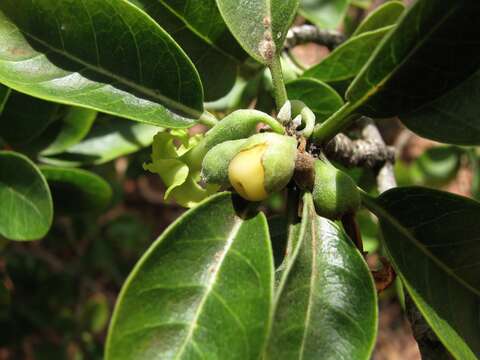Nothocestrum breviflorum

Description:
Aiea or Small-flowered aieaSolanaceae (Nightshade family)Endemic to the Hawaiian Islands (Hawaii Island)IUCN: Critically EndangeredOahu (Cultivated)Fruit shown here. Flowers, seen on this link, are very fragrant with a lemony smell.www.flickr.com/photos/dweickhoff/4741001594/in/photolist-...Treewww.flickr.com/photos/dweickhoff/10562766153/in/photolist...The city of Aiea, Oahu, State of Hawaii, USA, where I lived for several years, was named after the tree.Early Hawaiians used aiea in various ways. Botanist Joseph Rock (1913) wrote, The wood of this [species] is soft and of a green color; it was used by the natives in the olden days for finishing off canoes." The wood was also used in thatching sticks (aho) in house construction, and in canoe building for gunwales (moo) and the sharp point of the stern (moamoa).Fruits were sometimes eaten.Medicinally, the leaves, bark, and tap root were pounded, mixed with water, strained, heated with hot rocks, and cooled to use in the treatment of ph kolekole a aai (abcesses). It was also made into a liquid medicine with hia bark (Metrosideros spp.), moa holo kula (Psilotum nudum), and k honuaula (red/purple sugarcane) for ph kolekole.EtymologyThe generic name Nothocestrum is from the Greek nothos, false, and Cestrum, a large American genus with many species.The specific epithet breviflorum is from the Latin brevis, short-, abbreviated-, and flora, flower, referring to the small, or short, flowers of this species.nativeplants.hawaii.edu/plant/view/Nothocestrum_breviflorum
Included On The Following Pages:
- Life (creatures)
- Cellular (cellular organisms)
- Eukaryota (eukaryotes)
- Archaeplastida (plants)
- Chloroplastida (green plants)
- Streptophyta
- Embryophytes
- Tracheophyta (ferns)
- Spermatophytes (seed plants)
- Angiosperms (Dicotyledons)
- Eudicots
- Superasterids
- Asterids
- Solanales
- Solanaceae (nightshades)
- Nothocestrum (aiea)
- Nothocestrum breviflorum (Small-flowered Nothocestrum)
This image is not featured in any collections.
Source Information
- license
- cc-by-nc-sa
- copyright
- David Eickhoff
- photographer
- David Eickhoff
- original
- original media file
- visit source
- partner site
- Flickr Group
- ID


